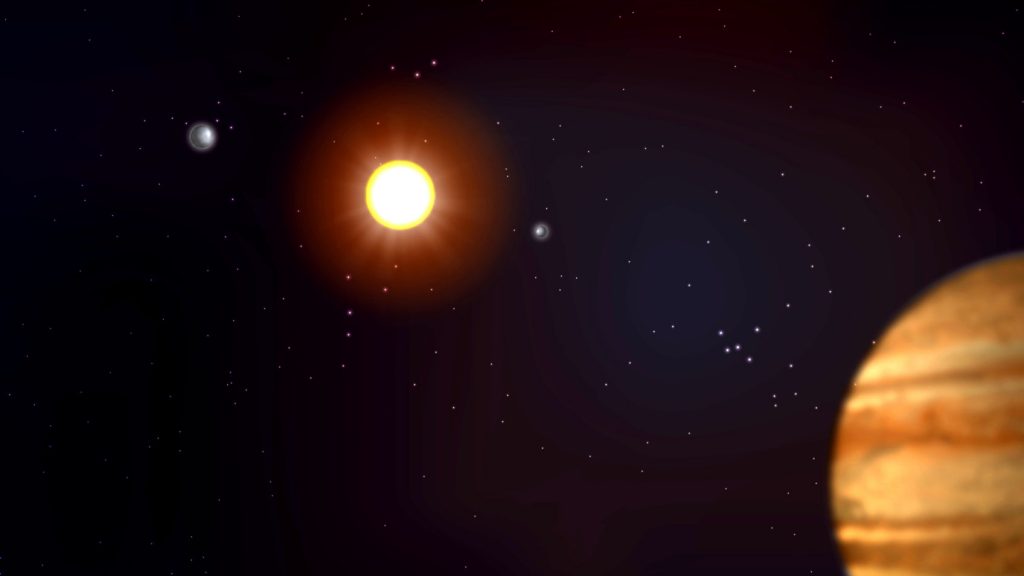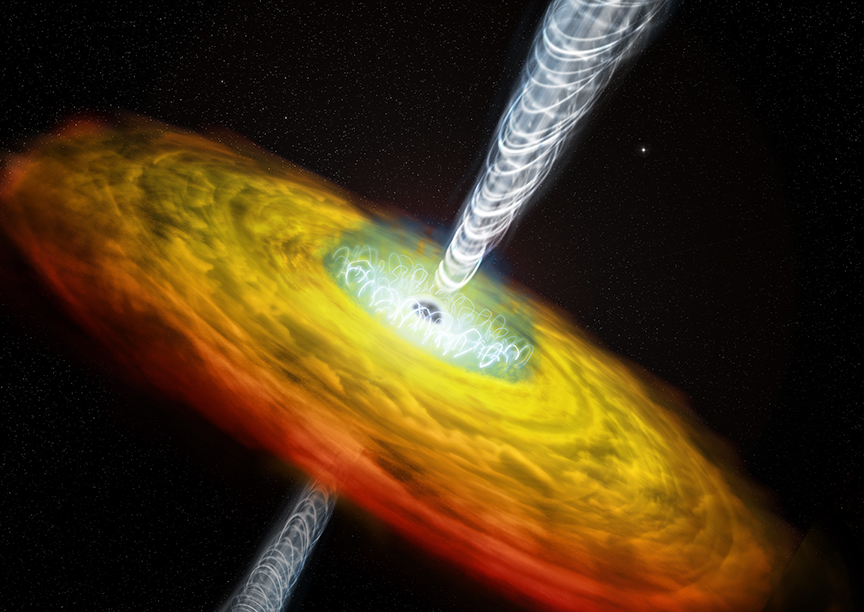Media
Transcript
Sometimes, we get papers and press releases where the cool news and the news they are trying to push forward are not entirely the same thing. Today, we received a pair of press releases about a new paper in Astronomy and Astrophysics concerning the relationship between the formation of large rocky worlds and Jupiter-like planets at middle-distances in our solar system. The headline states that “Earth-like Planets Often Come with a Bodyguard,” and then goes on to discuss new computer models being created at the Max Planck Institute for Astrophysics.

If you’re a long-time member of our audience, you know that computer models currently are pretty bad at describing planet formation, and this title and the article lede intrigued me because it implied that something we’ve long suspected is true can be reproduced in models, which would be awesome.
And then I read things in detail and realized, nope, what they have is a review of observations that shows that in the Venn diagram of solar systems layouts, 30% of systems observed to have large rocky worlds have a cold Jupiter, and all solar systems with a cold Jupiter have a large rocky world. Put another way, if a cold Jupiter is present, a large rocky world is always present, too, but there are also systems – in fact, there are more than twice as many observed systems – that have a known large rocky world and no matching cold Jupiter.
And the simulations discussed in the stories lede – they do not match what is being seen. Nope. Not at all. They ran 1000 simulations of planetary systems that evolved in a protoplanetary disk around a Sun-like star. Instead of all the cold Jupiters having a rocky world, only 30% of the simulated cold Jupiters had one. In the simulations, instead of 30% of the rocky worlds having a cold Jupiter, only 10% of them did.
They reason, and here I quote the press release: One explanation has to do with the rate at which gas planets gradually migrate inward. Planet formation theory seems to predict higher rates than observed, leading to an increased accumulation of gas giants on orbits of intermediate distance. In the simulations, these ‘warm Jupiters’ interfere with the inner orbits and cause more super-Earths to be ejected or even collide in gigantic collisions. With a slightly lower tendency of the simulated gas planets to migrate, more of the super-Earths would remain, which would be more compatible with the observations.
Here’s the thing though: these simulations have been done over recent years not weeks, and our understanding of solar system formation is changing so rapidly that these folks are missing new information on planets co-evolving at the same time as stars, with similar timescales for initial formation. Beyond having a mismatch in timelines, the simulations also – like all simulations – can’t accurately reproduce planetary migration because we don’t completely understand planetary migration.
This is a cool note of “Hey if you have a cold Jupiter, you’re going to have a large rocky world.” This implies something fundamental about how forming gas giants influence the formation of smaller bodies. The fact that only 30% of large rocky worlds have gas giants also implies there are either multiple formation mechanisms for large rocky worlds, or that there are mechanisms for eradicating cold Jupiters from view, or maybe both. This is cool.
This is just not the focus of the press release.
The reality is that folks most likely got funding to do extensive modeling of solar systems, and they absolutely did that to the best of their ability with the incomplete data we have. Having completed their work, they needed to publish their results, and they have results. But when your simulations and reality don’t entirely match… well, this is the kind of press release you get. It has cool results, just not the ones they were probably hoping for. Ideally, you want the simulations and reality to match, but science progresses through both successes and things that go sideways. It all contributes, and now we know these particular models are missing some key ingredients needed to describe our reality. And our reality is kind of cool.
Switching topics entirely, our next story takes us from planetary disks to galactic disks. In a new paper in Monthly Notices of the Royal Astronomical Society (MNRAS) with lead author Shifu Zhu, researchers are able to tease out the physics behind why some rapidly spinning supermassive black holes produce powerful jets and others do not. This is one of those cases where all systems with jets are rapidly rotating, but not all rapidly rotating systems have jets.

When an SMBH and its associated disk of infalling material are rapidly rotating, the moving charged particles can generate a powerful magnetic field. Material caught in the magnetic field can be ejected out along the rotation axes of the system and inject huge amounts of energy into the galaxy’s surroundings.
In this study, 729 quasars with jets were observed in the X-ray using the Chandra, XMM Newton, and ROSAT space telescopes; in radio with the Very Large Array (VLA); and optically with the Sloan Digital Sky Survey (SDSS).
According to Zhu: We found there’s another determining factor of whether a supermassive black hole has jets, something called a black hole corona threaded by magnetic fields. If you don’t have a black hole corona that’s bright in X-rays, it seems like you don’t have powerful black hole jets.
These black hole coronas don’t circle the black hole so much as they lay above and below the accretion disk surrounding the black hole. Zhu goes on to explain: Both a quasar’s powerful jets and bright corona occurring together may be fundamentally driven by magnetic fields.
One of the big take-aways from this research is that quasar jets don’t emerge at the disk but instead come out from higher up in the disk’s corona. Co-author Guang Yang explains: Finding that the X-rays in quasars with jets come from a black hole corona, rather than from the jets, challenges 35 years of thinking about the basic nature of this emission. “It could provide new insight into the physics of these jets.
The more we see of our universe, the more we see our own minor and sometimes major mistakes in our understanding of the universe. This is a minor update that makes it possible to finally understand the sporadic nature of jet creation around rotating SMBHs.
Our final story of the day reminds us that even the fundamentals of star formation and star cluster formation like to periodically mess with our understanding of how things work.
While it’s been understood pretty much as long as we’ve understood stellar metallicities that globular clusters are low in metal content, we thought there was a floor to just how low that metallicity could go in large globular clusters. Essentially, when the raw material of the universe formed the first few generations of stars, it didn’t form those stars into globular clusters, and the dynamics associated with forming globular clusters only occurring after a minor amount of processing had occurred.

Well, apparently, the universe decided it “didn’t need no stinking” metal-enrichment to form at least some super metal-poor large globular clusters. And by some, I mean we have found one.
Astronomers using the High-Resolution Echelle Spectrometer (HIRES) spectrometer on the Keck Telescope had a couple of hours of time remaining after completing their planned observations and took a look at the Andromeda galaxy’s globular cluster RBVC EXT8. They found that it is three times less metal-rich than normal globular clusters, 800 times less metal-rich than our Sun. This accidental discovery is published in the journal Science with lead author Soren Larsen.
This is yet another example of our universe not letting us get too comfortable in our understanding of how things work. It is unclear if this is a random pocket of unprocessed gas that got shocked into forming a globular cluster without forming heavy metal producing stars that enriched it to normal levels or if this is some other rare situation we haven’t anticipated.
Whatever is happening, when we finally get the observations needed to explain the weirdness of what’s going on, we’ll bring them to you here.
Learn More
Earth-like Planets Often Come with a Bodyguard
- MPIA press release
- “The New Generation Planetary Population Synthesis (NGPPS). III. Warm
Super-Earths and Cold Jupiters: A Weak Occurrence Correlation, But with a
Strong Architecture-Composition Link,” M. Schlecker et al., 2020, in Astronomy & Astrophysics (preprint on arxiv.org)
The Recipe for Powerful Quasar Jets
- Chandra press release
- NASA press release
- “The Lx-Luv-Lradio relation and corona-disc-jet connection in optically selected radio-loud quasars,” S. F. Zhu et al., 2020 June 20, Monthly Notices of the Royal Astronomical Society (preprint on arxiv.org)
Astronomers Discover Metal-Poor Globular Cluster
- NOVA press release
- “An Extremely Metal-Deficient Globular Cluster in the Andromeda Galaxy,” Soren S. Larsen, Aaron J. Romanowsky, Jean P. Brodie & Asher Wasserman, 2020
Oct. 16, Science
Credits
Written by Pamela Gay
Hosted by Pamela Gay
Audio and Video Editing by Ally Pelphrey
Content Editing by Beth Johnson
Intro and Outro music by Kevin MacLeod, https://incompetech.com/music/


 We record most shows live, on Twitch. Follow us today to get alerts when we go live.
We record most shows live, on Twitch. Follow us today to get alerts when we go live.